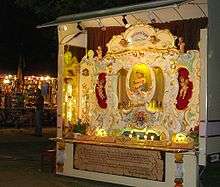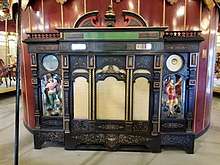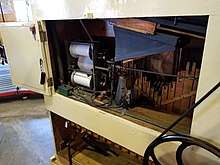Fairground organ
A fairground organ (French: Limonaire) is a pipe organ designed for use in a commercial public fairground setting to provide loud music to accompany fairground rides and attractions, mostly used on merry-go-rounds. Unlike organs intended for indoor use, they are designed to produce a large volume of sound to be heard over and above the noise of crowds of people and fairground machinery.



History
As fairgrounds became more mechanised at the end of the nineteenth century, their musical needs grew. The period of greatest activity of fairground organ manufacture and development is from the later 1880s to the introduction of effective electrical sound amplification in the mid-1920s. The organ chassis was typically provided with an ornate and florid decorative case façade designed to be a further fairground attraction in its own right as with all fairground equipment.
The ornate case façades frequently had different instruments such as a Glockenspiel or drums that provided visual entertainment as they played. There were often ornate human figures such as a conductor whose arm moved in time to the music or women whose arms would strike bells. The mechanics to accomplish this motion were quite intricate and provided a pleasant visual experience in addition to the music.
The organs were constructed so as to be able to produce the popular music of the period. Organs were designed to mimic the musical capabilities of a typical human band. For this reason they are known as band organs in the United States.
The motive force for a fairground organ is typically wind under pressure generated from mechanically powered sets of bellows mounted in the base of the instrument. The instruments, designed to be operated without a human performer, are keyboard-less apart from a few one-off examples. The organ is played mechanically by either a rotating barrel with the music pinned thereon like a music box, a strip of cards perforated with the musical data and registration controls called book music, or interchangeable rolls of paper similarly programmed called music rolls. However, Victory, pictured above, while a traditional mechanism plays traditional books, it also contains a Yamaha MIDI interface and is most often played electronically – with a blank card in place of the traditional book. Owner Willem Kelders uses this interface to link organs (Rhapsody and Locomotion, driven by Victory) together so they all play the same music perfectly synchronised.
Fairground organs were used in many settings such as general fairground rides, static side shows such as bioscope shows and various locations in amusements parks such as ice rinks and the like.
Manufacturers of fairground organs also typically made instruments for indoor usage in a dance hall called a dance organ and travelling street use called a street organ.
Like all mechanical instruments, fairground organs come in a vast array of sizes and technical specifications made by a myriad of manufacturers all of which had their own trademark characteristics. As with all vintage equipment there is a strong preservation movement associated with these instruments and today new instruments and music are still being made.
Operation

Early organs were designed to be compact and operated by an unskilled person or mechanically. These were played via an integral pinned barrel requiring no human input apart from changing the number of the tune being played. These had a fixed repertoire and, if it was desired to change the tunes, a complete new pinned barrel was required. To offer a more flexible choice of repertoire, a system of robust interchangeable perforated cardboard book music was adopted first by Parisian manufacturers Gavioli. Their system became widely regarded as commercially advantageous and other manufacturers followed suit. Book music offered a cheaper and more readily updated alternative to barrel music. Also used by many manufacturers including Gavioli was operation via paper music roll. These rolls were more compact and cheaper to manufacture than book music. Technically, they were more susceptible to poor handling but all systems experienced their own types of characteristic wear and tear during repeated playing. Both "book" and "roll" systems were manufactured with different operating actions which read the music via air pressure, under suction, or mechanically. To extend longevity, mechanically read cardboard book music was typically strengthened with an application of shellac. Music rolls were typically fortified via the use of robust moisture-resisting paper stocks.
All the functions of the organ are (apart from the smallest instruments) operated automatically from the music media. Larger instruments contain automatic organ stop register control and additional control tracks for operating percussion instruments, lighting effect and automaton figures.
Builders
- NOTE: non-exhaustive list of builders, past and present
| Name | Country | Location | Fairground | Dance | Street | Notes | Website |
|---|---|---|---|---|---|---|---|
| Artizan Factories, Inc | North Tonawanda, NY | ||||||
| B.A.B. Organ Company | Brooklyn, NY | Converted European organs to the B.A.B. roll system | |||||
| Alfred Bruder | Waldkirch | ||||||
| Gebrüder Bruder | Waldkirch | ||||||
| Ignaz Bruder Söhne | Waldkirch | ||||||
| Wilhelm Bruder Söhne | Waldkirch | ||||||
| Chiappa & Sons | London | ||||||
| Cocchi, Bacigalupo & Graffigna | Berlin | ||||||
| Eugene de Kleist | North Tonawanda, NY | Expatriate German who trained at Limonaire Frères in Waldkirch. While running his own business in London, was persuaded by American fairground ride maker Allan Herschell to start production in North Tonawanda, New York. Founding the North Tonawanda Barrel Organ Factory in 1892, he created the American Band organ sound. Business partner Rudolph Wurlitzer bought his interest in the business in 1909 after he was elected mayor of North Tonawanda | |||||
| Dean Organ Builders | Whitchurch, Bristol | John Dean established himself as wheelwright and cabinet maker circa 1818 in Bridport, but it was his grandson, Thomas Walter Dean who moved the family and their business to Bedminster in Bristol, following his marriage in 1899 to the daughter of a local dealer, William Wyatt. Walter Deans son Edwin, moved his business to Whitchurch in 1939 and so established the present site where the retail shop and workshop are today. Under the direction of Edwin Dean's son, Michael, the family turned its attention to the building of new traditional fairground and street organs. It was at this time that the company became known as Dean Organ Builders. The company introduced the 20 keyless book playing organ. The business continues in the hands of Richard and Sue Dean. | |||||
| Fr. Decap | Herentals | ||||||
| Decap, Gebroeders (Decap Brothers) | Antwerp | Founded in 1902 by Aloïs Decap, the name was changed when taken over by the four sons: Livien, Frans, Léon, Camille. Maker of dance organs (early years), mechanical pianos (limited production, early years), street and fairground organs (1920s-1930s). Leading maker of dance organs, 1930s-present. Business now runs by Camille's daughter Martha, her husband Louis Mostmans and son Roger under the name Decap Brothers of Antwerp. | |||||
| Pierre Eich | Ghent | ||||||
| Marc Fournier | Seyssuel | ||||||
| Frati & Co. | Berlin | ||||||
| Carl Frei | Waldkirch Breda |
Started in Waldkirch, moved to Breda via Belgium. Returned to Waldkirch after World War II | |||||
| Gaudin Freres & Cie. | Paris | Successors to Marenghi | |||||
| Foucher-Gasparini | Paris | ||||||
| Gavioli & Cie. | Paris | At one point, the largest organ builder in the world. Ceased trading in 1910, with patents, designs and brand sold to rival Limonaire Frères | |||||
| Theo Heesbeen | Tilburg | ||||||
| Louis Hooghuys | Geraardsbergen | ||||||
| Jäger und Brommer | Waldkirch | ||||||
| Johnson Organ Company | Fargo, ND | ||||||
| La Salvia | Buenos Aires | Since 1870 | |||||
| Le Ludion | Toulouse | ||||||
| Lemoine-Dussaux | Paris | ||||||
| Limonaire Frères | Paris | Founded in Paris in the 1830s by a group of brothers, the company went through various iterations before becoming the second largest producer of organs behind Gavioli. At their height from 1900 to 1914, they had factories in both Paris and Waldkirch, Germany. Bought the patents and what remained of rival Gavioli from administrators in 1910. German factory was confiscated during World War I, and after return in 1921 sold to Alfred Bruder in 1924. Company ceased trading in 1936. | |||||
| Charles Marenghi & Cie | Paris | ||||||
| Usines Theofiel Mortier | Antwerp | ||||||
| Nederlands Boekorgel Centrum | Tilburg | ||||||
| Niagara Musical Instrument Mfg. Co. | North Tonawanda, NY | ||||||
| Emmanuel Odin | St. Rambert | ||||||
| John Page | Milton Keynes | Formerly Page & Howard | |||||
| G. Perlee Draaiorgels | Amsterdam | ||||||
| Elbert Pluer | Bussum | Son of Anton Pluer | |||||
| Pooker Organ Works | Hawthorne, CA | ||||||
| Gebrüder Richter | Düsseldorf | ||||||
| Andreas Ruth & Sohn | Waldkirch | Makers of the organ formerly at the Myrtle Beach Pavilion amusement park, now located at a smaller park in the city.[1]:93 | |||||
| Stinson Organ Company | Bellefontaine, OH | ||||||
| Sturm Olivier | Saint-Jean-du-Pin | ||||||
| van Steenput Frères | Puurs | Built and converted fairground and street organs circa 1890-1930 | |||||
| Verbeeck | Antwerp London |
Five generations of family members have built and repaired portable hand-cranked organs, street organs (including the world-famous Dutch street organ "The Arab"), fairground organs, and dance organs since 1884. Business names have included:
|
|||||
| Heinrich Voigt Orgelbau | Höchst, Frankfurt am Main | ||||||
| Gebrüder Wellershaus | Mülheim | ||||||
| Fritz Wrede | Hanover | ||||||
| Rudolph Wurlitzer Company | North Tonawanda, NY | After collaborating with Eugene de Kleist on the Wurlitzer Tonophone, bought into the North Tonawanda Barrel Organ Factory business from 1897, and then bought De Kleist's interest in 1908. Moved all production of organs to the site, and began heavily investing. Organ production ceased in 1942, with the factory turned over to producing proximity fuzes. Post war, the factory produced various Wurlitzer lines, including radios and jukeboxes. The factory closed in 1973. | |||||
See also
- Barrel organ
- Dance organ
- Calliope
- Mechanical organ
- Orchestrion
- Organ grinder
References
- Stokes, Barbara F. (2007). Myrtle Beach: A History, 1900-1980. Univ of South Carolina Press. ISBN 978-1-57003-697-2.
- Bopp, Ron: The American Carousel Organ: An Illustrated Encyclopedia. Grove, OK: Ron Bopp, 1998.
- Bowers, Q. David: The Encyclopedia of Automatic Musical Instruments. Vestal, NY: Vestal Press, 1972.
- Jüttemann, Herbert: Waldkircher Dreh- und Jahrmarkt-Orgeln. Waldkirch: Waldkircher Verlag, 1993.
- Jüttemann, Herbert: Waldkirch Street and Fairground Organs. Rufforth, York: A.C. Pilmer, 2002. (Revised translation of above)
- Reblitz, Arthur A.: The Golden Age of Automatic Musical Instruments. Woodsville, NH: Mechanical Music Press, 2001.
- Reblitz, Arthur A. and Bowers, Q. David: Treasures of Mechanical Music. Vestal, NY: Vestal Press, 1981.
- Cockayne, Eric V. The Fair Organ — How It Works. UK, published by The Fair Organ Preservation Society
External links
| Wikimedia Commons has media related to Fairground organs. |
- Fair Organ Preservation Society
- The Carousel Organ Association of America
- Kring Van Draaiorgelvrienden
- Mechanical Organ Owners Society
- Australian Mechanical Organ Society
- Automatic Musical Instrument Collector's Association
- Fairground Organ Collector Paul Eakins on 1970 Program "Perception" Hosted by Dick Bertel on WTIC-TV in Hartford, Connecticut

